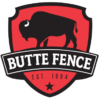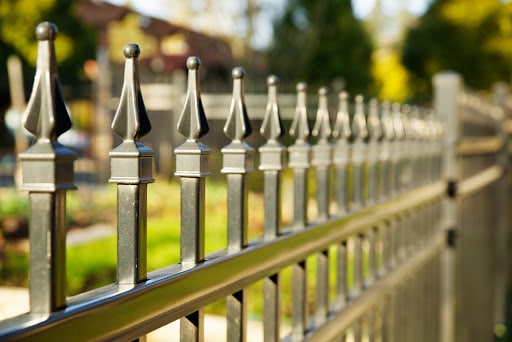Wrought iron fencing is a classic option that was once reserved for wealthy landowners because of its labor-intensive design. However, thanks to modern manufacturing methods, this timeless look is now available for any homeowner who appreciates the sophisticated appeal of wrought iron fencing.
But as with any type of fencing option, your wrought iron fencing will need some maintenance from time to time. The frequency with which you will need to perform wrought iron fence repair will depend on several factors, such as the material used to create your wrought iron fencing, the location where you live, and the quality of the original installation.
Wrought iron fencing was traditionally made from actual wrought iron, which is iron ore that has been hammered into shape with inclusions made of slag that give the wrought iron its distinctive appearance.
On the other hand, modern wrought iron fencing is made from a variety of materials, such as galvanized steel and aluminum. It’s important to keep in mind that the material used to create your wrought iron fencing will play a big part in determining what kinds of wrought iron fence repairs you will need to perform and how often your wrought iron fencing will need maintenance.
In this guide to wrought iron fence repair, we will discuss some of the common issues that homeowners run into with different types of wrought iron fencing, as well as some of the key characteristics of each type. We will also provide a brief overview of how you can perform different kinds of wrought iron fence repair.
Wrought Iron Fence Repair
As we mentioned above, the material used to fabricate your wrought iron fencing will be the deciding factor in what kinds of repairs your fencing will need periodically. Let’s take a look at the three major types of wrought iron fencing, along with their pros and cons and some of the most common issues presented by each of these designs and their materials.
Wrought Iron Fencing
True wrought iron fencing is far less common today than it was in the past, mostly due to its labor-intensive fabrication and high susceptibility to rust.
Rust, also known as oxidation, is a chemical process through which iron atoms react with oxygen from the atmosphere, causing the iron to turn into a more stable chemical compound known as iron oxide.
When an untreated iron surface is exposed to air, it will begin to rust almost immediately. As such, true wrought iron fencing will require frequent maintenance and repairs to preserve the integrity of the fence’s structure. These can include removing rust with abrasive materials like sandpaper and grinding wheels, as well as painting with rust-resistant paints made especially for metal surfaces.
Rust Removal – Although it is next to impossible to completely prevent wrought iron fencing from oxidizing, there are several ways in which you can slow down the chemical process and extend the life of wrought iron fencing. One of the first things you will need to do to accomplish this is to remove the oxidation from the fence’s surface.
Here is a list of the tools and items you will need for the job:
- Protective gear
- Drop cloths
- Wire brushes
- Sandpaper
- Angle grinder
- Grinding wheels
- Rust removing compounds
- Buckets
- Rags
First, you will want to lay out a drop cloth below the area of fencing that you will be working with to keep rust from falling into your grass or onto your pavement. This is an important step, especially when working near driveways or sidewalks because rust can permanently stain these surfaces.
Next, you will want to be sure to put on some protective gear, such as gloves and eye protection. This will prevent rust particles from landing in your eyes when removing the outer surface of your rusty fence.
After you have ensured that you are fully protected against the materials and tools you’ll be working with, you can proceed to use a combination of an angle grinder with wire wheels, wire brushes, and sandpaper to remove as much rust as possible from the entire fence. It is important to give extra attention to all of the nooks and crannies within your fencing because these tend to be the first areas to begin to rust, which can lead to holes and fractures in your fence’s material.
Once you have removed as much rust as possible with these tools, it’s a good idea to treat the surface of your fence with a rust-removing compound. Be sure to carefully read the instructions on the bottle before using. It is also important to wear a good pair of rubber gloves during this process since these chemicals can be caustic and harmful to human skin.
After applying your rest removal compound and allowing it to sit for the recommended amount of time, make sure you give your fence a good rinsing to remove all of the chemicals from your fence’s surface. Also, use your rags to thoroughly dry the fence to prevent further rusting before the next step.
Painting – After you have removed all of the rust from your fence’s surface, it is time to seal it up with a high-quality, rust-resistant primer and paint. Adding a layer of rust-resistant primer is a crucial part of the step since it will add an extra protective coat to prevent further rusting.
You can choose from several options when it comes to finding the right paint for your fence, including different colors, brands, and types of paint. But if you are trying to finish this project on a tight budget, it may be a good idea to go with liquid paint rather than spray paint.
While spray paint can provide a more consistent finish, it can be quite a bit more expensive than liquid paint, especially if you are treating large sections of wrought iron fencing. Whether you choose to use liquid or spray paint, be sure that you are using paint that can adhere to wrought iron and prevent rust from forming below the paint’s surface.
Galvanized Steel Wrought Iron Fencing
Galvanized steel is a common material used to make wrought iron fencing due to its durability and corrosion resistance. However, if the layer of galvanization is compromised, your steel fencing will become susceptible to rust.
Galvanization – Galvanization is the process of coating steel or iron with a layer of zinc to prevent corrosion. The most common way this is achieved is by dipping the material into a bath of molten zinc, then allowing the zinc to harden on the steel’s surface. Although zinc is a somewhat hard metal, measuring 3/10 on the Mohs scale, it is also extremely brittle, making it prone to cracking and chipping.
For example, if your galvanized steel fencing was to get hit by a piece of gravel thrown by a lawn mower, it could easily compromise the layer of galvanization, exposing the fence to oxidation. The good news is that steel rusts much more slowly than true wrought iron, which will give you plenty of time to treat the oxidized area before it is able to completely rust through your fence.
Painting – The process for treating a galvanized steel fence is similar to that of a wrought iron fence, meaning that you will need to remove the rust and paint the fence with a suitable type of rust-resistant paint.
However, galvanized steel wrought iron fence repair doesn’t always come down to removing rust and painting. Although galvanized steel wrought iron fencing is extremely durable, it can be damaged beyond repair, as with any other type of fencing. For example, if your wrought iron fencing was to get hit by a car or lawn mower, you would most likely need to replace at least a portion of your fencing.
Replacing Panels – Modern wrought iron fencing often comes in panels, making it extremely easy to replace large sections of fencing for your wrought iron fence repair. Depending on how your panels are fitted together, you may even be able to accomplish this with some common household tools. Most modern wrought iron fencing panels can be fastened together with simple nuts and bolts, allowing you to remove and replace sections as needed.
Although it is less common, your galvanized steel wrought iron fencing could be welded together. If this is the case, it is important to pay close attention to the welded joints to ensure that they are not rusting, as this tends to be the first place where oxidation will occur.
This is due to the fact that welders will grind the layer of galvanization off of the areas they will be welding to make a clean and solid joint. If the joints are not properly treated with rust-resistant primer and paint after welding, they can quickly rust and weaken your fence’s integrity.
Aluminum Wrought Iron Fencing
Aluminum wrought iron fencing is becoming an ever more popular choice for homeowners who are looking for the timeless appeal of wrought iron aesthetic without the costly price tag. Aluminum is a lightweight alternative to stainless steel and wrought iron that has inherent rust-resistant properties.
Rust Resistance – Although it is impossible for aluminum to rust the way that iron and steel do, aluminum can corrode. However, the difference here is that aluminum corrosion will not compromise the integrity of your fence. Aluminum oxide is an extremely strong chemical compound that will actually strengthen the fence’s surface without damaging its layer of paint.
Strength – Another added benefit of aluminum wrought iron fencing is its incredible strength relative to its weight. Although stainless steel has a higher tensile strength, aluminum has a much higher strength-to-weight ratio. What this means is that when you compare equal weights of steel and aluminum, aluminum can often outperform steel.
Cost Effectiveness – In addition to its durability, aluminum wrought iron fencing is also extremely popular among homeowners due to its low cost. Aluminum is an extremely abundant element that is easy to reuse and recycle. To give you an idea of the cost difference between steel and aluminum, the scrap weight price for aluminum is around $.50 per ton, while the scrap weight of steel is around $180 per ton. While scrap weight pricing can vary depending on availability, steel is still around 360 times more expensive than aluminum, making aluminum the clear winner in terms of cost-effectiveness.
Aluminum Wrought Iron Fence Repair
Because aluminum wrought iron fencing is impervious to rust, you will never need to worry about this when it comes to aluminum wrought iron fence repair and maintenance. However, there may be times when you need to touch up the paint on your aluminum wrought iron fencing. To go about this, you will need to make sure that the paint you are purchasing will adhere to an aluminum surface, and it is also important that the color you are using for your aluminum wrought iron fence repair matches its factory coating.
If you ever run into a situation where your wrought iron fence repair requires you to replace an entire panel of aluminum wrought iron fencing, chances are that your fencing will be fitted together with nuts and bolts, much like we described when talking about galvanized steel wrought iron fencing.
Before removing and replacing a section of damaged fencing for your wrought iron fence repair, it is a good idea to consult with your fencing retailer to ensure that the process is done correctly and safely without voiding your manufacturer’s warranty.
Butte Fence
Butte Fence is a locally-owned professional fencing company proudly serving the Treasure Valley and Magic Valley areas of Idaho since 1994. We sell and install various kinds of fencing from some of the country’s top manufacturers, including vinyl, hardwood, wrought iron, chain link, and concrete stone fencing.
In addition to providing top-quality fencing supplies and installation, we can also build and install gazebos, gates, boat docks, patio covers, and decks.
So if you are a homeowner in need of wrought iron fence repair or any other type of fencing service, click here to get in touch with one of our knowledgeable representatives for answers to all of your fencing questions.


